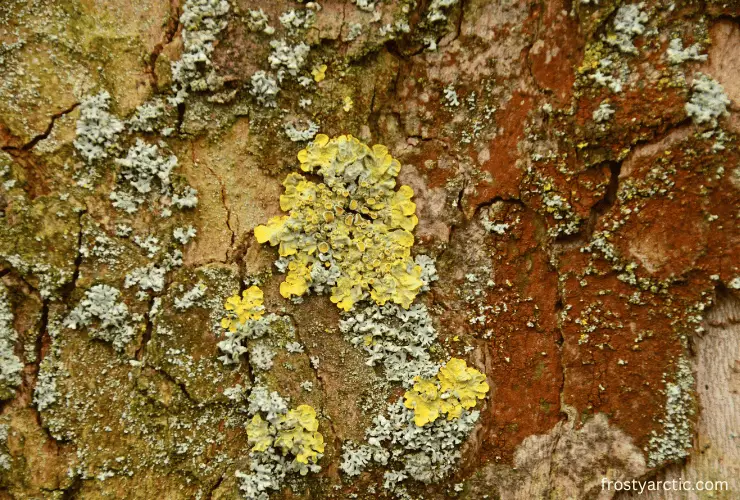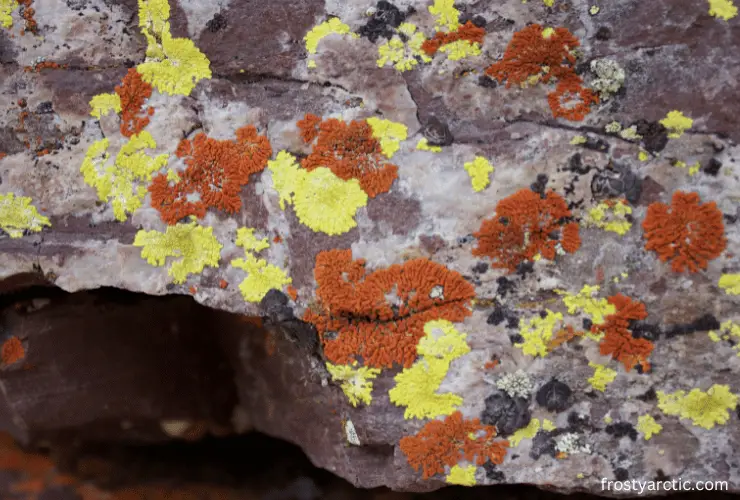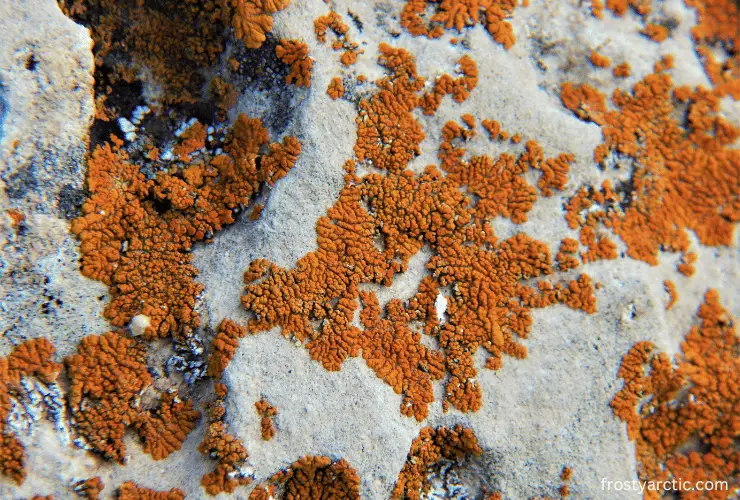Crustose lichen is a composite organism with a symbiotic relationship with algae and fungi. It doesn’t contain any lobe, and its thin and flat crust adheres inseparably to any surface. Also, the color of the foliage of crustose lichen varies with its species.
Crustose Lichen is indeed an interesting organism with its characteristics. Throughout this article, I will enlighten you about their growth behavior, requirements, types, and species. You will also learn about their adaptations, reproductive factors, and uses. Now, let’s dive into the article.
Crustose Lichens at a glance
| Parameters | Details |
| Plant type | Doesn’t consider a plant |
| Plant size | Small |
| Scientific Name | Lecanora conizaeoides |
| Leaves size | Small |
| Width | 1 cm in diameter |
| Soil condition | Rocky |
| Watering | Normal |
| Sun exposure | Several hours a day |
| Leaf color | Deep green |
| Color | Green, orange, yellowish, reddish |
| Blooming season | No particular season |
| Toxicity | Some species |
| Uses | Medical, food, industrial |
Which Is a Crustose Lichen?
A lichen is a composite organism that forms a symbiotic partnership with fungus and algae. There are three kinds of lichens. Among them, crustose is the most famous one.
Crustose lichens are a type of lichen that forms a crust over a substrate. Usually, they adhere to the substrate so strongly that it is nearly impossible to separate them.
Generally, Crustose lichens are found in rocks. Sometimes they are seen on tree bark, also. These lichens are divided into many subtypes. The growth of the lichens is moderately slow.
Crustose lichens have no specific colors. Although they look beautiful for their unique colors and separation, most lichens are bright. Moreover, these lichens always possess a higher cortex.
Why Is It Called Crustose Lichens?
To know the history behind the naming of the crustose lichens, you have to know the meaning of crustose first. Crustose comes from the word crust.

Now, what is the meaning of crust? Well, the crust is a solid outer layer of the earth that lies over the mantle.
Now, crustose lichens appear in the form of crust over a surface. They form like boulders, cars, or roof shingles and are attached tightly to the surface. From every angle, it looks like a crust. That’s why it is called Crustose lichens.
Where Do Crustose Lichens Grow?
The Crustose lichens have no specific area for growth. Typically, they can be found on rocks as well as on the surface of leaves also. Besides, they can thrive in karst areas that are rich in carbonate.
In southern China, these are more famous than in any other area. In bare karst areas, around 5-30% of rock outcrops are covered with crustose lichens, while forest karst area has more than this number. About 30-70% of the site is covered with these lichens there.
However, they can also grow in higher-elevation areas, especially in the western Himalayan area. Terricolous lichens, a type of crustose lichen, appear in high concentrations in the mountains region.
Moreover, if there is any place unsuitable for growing plants, it will be normal for crustose lichen to appear there.
How Do You Identify a Crustose Lichen? [Appearance]
When it comes to identifying crustose lichens, you need to know their physical characteristics very well.
First of all, identification comes with color detection. Usually, these types of lichens appear in bright and vibrant colors.
Crustose lichens have no specific color. Sometimes they appear in yellow, sometimes in orange or red color. Grey and green crustose lichens are also found in some regions.
The thallus of the lichen is powder-like. The crustose lichen consists of a cortex layer on the upper side. Usually, the cortex layer is differentiated.
Crustose Lichen Types
Crustose lichen is one of the types of lichen. The crustose lichens are further divided into several subtypes. You can find many types of crustose lichens around you. Most commons are:
| Types of crustose Lichens | Description | Example |
| 1)Epilithic | These are usually found on top of a rock as they can’t penetrate the substrate. | Acarospora fuscata |
| 2)Endolithic | These can penetrate a rock substrate and grow inside the rock. They have a developed upper cortex. | Genus Lecidea |
| 3)Squamulose | Partially separated from the substrate. The appearance is scale-like. You can consider it an intermediate form. | Genus Catapyrenium |
| 4)Powdery | The organized thallus is absent. The thallus appears like powder. You can consider it the simplest subtype. | Genera Vezdaea |
| 5)Peltate | The thallus of this lichen is attached to the central area. Otherwise, it is similar to the other subtype Squamulose. | Peltula euploca |
| 6)Endophloeodic | Usually grows underneath the stem. Sometimes may grow underneath the dead skin of leaves | Amandinea punctata |
Crustose Lichen Species
There are numerous types of Crustose lichen, and you may find them in different parts of the globe.
Generally, you can find them mainly in high-light intensity areas. They need humidity of 90% and grow well at 18-19°C. Researchers identified 20 species of crustose lichens. Those are:
| Species | Thallus Color |
| Graphina anguina | Grey |
| Graphina ruiziana | Greenish grey |
| Graphis elegans | Greenish grey |
| Graphina ruiziana | Whitish or greenish grey |
| Graphina columbina | Brownish to greenish |
| Graphics galucescenes | Whitish to greenish grey |
| Graphics scripta | Greya |
| Phaeographics lyelli | Green |
| Graphidaceae | Brownish grey |
| Megalospora campylospora | Greenish grey |
| Megalospora cf. sulphurata | Greenish grey |
| Megalospora kalbii | Grayish white |
| Pertusaria amara | Grayish white |
| Pertusaria corallina | White to pale grey |
| Pertusaria sp. | Gray |
| Pachyphiale carneola | Dull green |
| Lepraria sp | Grayish white |
| Phlyctis agelaea | Gray |
| Lecanora carpinea | Grayish green |
| Lecania cyrtella | Grayish green |
| Cyphellium inquinans | Grey to reddish yellow |
Is Crustose Lichen A Fungus?
First, Crustose lichens appear in different sizes and colors, and sometimes plant-like appearance is detected. But they are not a plant.
We have already discussed that crustose lichen is a composite organism with a symbiotic relationship.
Crustose, as well as all lichens, are two organisms. These two organisms act like a single organism and function like a single one.
They are not a fungus or not alga; they are both. Although the internal structure and the outer skin are made of fungal hyphae, they are still not considered a fungus.
Crustose Lichens Adaptations
Adaptation is the process of adjustment to the environment. However, crustose lichens can grow and adapt in any place or situation. The adaptation process is:
- Forming Pigments: Much work in the Antarctic came up with the formation of pigments. Lichen forms sun-screening pigments to adapt to high light. The mycobiont plays a vital role in forming these pigments.
- Photosynthesis process: The fungi are not capable of the photosynthesis process. Algae are the main organism that causes photosynthesis to produce food. Crustose lichens are capable of exhibiting photosynthesis even if the temperature is below -20°C.
- Moisture absorption: Crustose lichens can withstand extremes of moisture as well as temperature. If moisture is available in the air, the fungus takes it. For this reason, a mechanical change occurs that leads to more light get through for photosynthesis. In a dry atmosphere, lichens remain in a dormant state.
How Much Sun Do Crustose Lichens Need?
Crustose lichens need full sunlight for their survival. Without sunlight, they will die slowly and fade out.
Although lichens can grow and adapt in all conditions and places, for further growth, lichen needs sunlight. The temperature can vary from cool to warm. Normally, the 18-25°c temperature is sufficient for crustose lichens.

Lichens produce their food in photosynthesis, which is why they need sunlight for at least a few hours a day. But exposure to too much sunlight can cause some issues. Green pigments will fade out if there are no sufficient hours of sunlight.
How Do Crustose Lichens Reproduce?
Lichens are unique because they are composed of two organisms: fungi and algae. Crustose lichens are plant-like but not plants. So, they can’t produce more lichen in a similar process to plants.
The lichens can produce their body both sexually and vegetatively.
- Sexual reproduction: Although lichens are made of fungi and algae, only the fungi body can produce sexually. Some photobiont species can be found in lichens.
They are free living and can produce sexually. Sexual reproduction is divided into two types. They are ascomycetes and basidiomycetes.
- Vegetative reproduction: Many lichens will create new life from thallus fragments that break off. Each fragment, which in theory works much like a cutting taken by a gardener who wants to perpetuate a certain plant, comprises both mycobiont and photobiont cells.
A thallus fragment also propagates an existing genetic makeup, and the gardener’s cutting is genetically similar to the parent plant, hence a means of vegetative reproduction.
Are Crustose Lichens Edible?
The answer is yes, it is edible. Most of the lichens are edible for their nutrient value.
In some regions, people eat lichens as a replacement for some vegetables. Some use lichens as a staple food. Generally, lichens are eaten after cooking it.
However, you need to keep in mind that some crustose lichens are poisonous. Make sure whether it is safe or not before cooking a lichen. Moreover, an excessive amount of lichen can cause pain in the stomach.
Crustose Lichens Taste
The taste of crustose lichens plays a vital role in eating it. The bitter taste keeps a negative effect on most people. But the good news is that crustose lichens taste sweet, so it attracts people to eat them.
The crustose lichens have a mushroomy flavor. Sometimes the lichens taste bitter at first. But it turns sweeter over time.
Some types of crustose lichen taste bitter, like aspirin. But you can cook them in your style to make them taste good.
Crustose Lichens Uses
Lichens have helped humans in many ways since ancient times. People use lichens in many aspects of their life. From industry to personal life, crustose lichens have many uses, including the following:
1. In textile processing
Lichen dyes play a significant role in textile industries. Many of the raw dyes can be produced by using crustose lichens. For years, crustose lichens were famous for making purple and violet colors.
In ancient times, these lichens were used for dyeing silk. Yellowish and reddish colors are also obtained by boiling the crustose lichens in water.
2. Source of medicine
Crustose lichens derive from some bioactive compounds. These compounds hold some biopharmaceutical applications.
From these, antioxidants and antibacterial formulas can be found and produced. Some crustose lichens are used as a medicine for oral inflammation.
3. Cosmetics ingredients
Crustose lichens are famous for cosmetics ingredients in America and Europe. From deodorant to baby oil, these lichens can play a vital role as ingredients of products.
Crustose lichens hold an acid called usnic acid. This acid has widespread use as fragments.
What Animals Eat Crustose Lichens
Lichens is a favorite food for some animals. Mostly deer like the crustose lichens. You may observe that some insects are also fond of crustose lichens.
As crustose lichens have nutrient value for animals and taste good, they sometimes like to eat these instead of grass. Some birds also eat the crustose, which grows in tree substrates.
Some mountain goats, as well as caribou, also eat it. Mostly, lichens play a significant role in the food chain of reindeer. Moreover, some insects, such as oribatid mites and lepidopterans, live fully on crustose lichens.

In precise, animals that are in Crustose lichen’s predator list are:
- Deer
- Lepidopterans
- Oribatid mites
- Birds
- Mountain goats
- Caribou, etc.
What Did Native Americans Use Crustose Lichens For?
The native Americans were the first who used lichens in various ways. Some of those are:
- Food source: Due to being rich in some specific nutrients, the crustose lichens had popularity among the native Americans. They used it as food for them.
- Medicinal purposes: This plant has numerous therapeutic benefits. Thus, from ancient times, Native Americans have used this for medicinal purposes.
- Dye: Native Americans started to use lichens to make dye. They used its colorful thallus to make different types of dyes.
- Clothing purpose: They used to use crustose lichen to make dry wool. After that, Native Americans used those dry wools as their clothing materials.
- Blanket: They used to fill their blanket or mattress with crustose lichen. As a result, the blanket could give better warmth and could block the cold from entering through the blanket.
Is Crustose Lichens a Medicinal Plant? Medicinal Use of Crustose Lichens
Crustose lichens can be considered medicinal plants because of their nutritional value. Mainly, they are rich in vitamins A and D, but all types of crustose lichens are not medicinal plants. Some of their medicinal uses are:
1. Prevent the Risk of Cancer
Crustose lichen contains higher amounts of vitamin D, and increased intake can reduce the risk of colorectal cancer. Also, a higher intake of crustose lichen could prevent other types of cancer, like myeloma, prostate, and breast cancer.
Also, vitamin A in the crustose lichen helps prevent cell damage. Thus, a higher intake of it can prevent different types of tumors and breast cancer.
2. Prevent night blindness
Deficiency of vitamin A damages the retina and cornea of the eyes. As a result, your eyes won’t be able to make pigments in low-light conditions. This condition is termed night blindness.
If you intake crustose lichen, its vitamin A portion will help you maintain your normal vision. It will prevent your core
3. Healthy immune system
Crustose lichen is high in a variety of nutrients, and it boosts the immune system of your body. The nutrients of this plant boost the growth of immune cells. As a result, your immunity to multiple diseases also increases.
4. Solve digestive issues
Crustose lichen serves as fiber in your body if you consume it. This dietary fiber is helpful in various digestion issues like constipation and diarrhea.
In case of constipation, fiber from crustose lichen will add to your stool which will make the stool soft. This will ease your bowling difficulty.
And, when you suffer from diarrhea, the dietary fiber adds weight to the stool and solidifies it. As a result, your diarrhea symptoms will reduce.
5. Stops bleeding
Vitamin D of this crustose lichen has anticoagulant effects. Thus, It can immediately stop heavy bleeding from injured sites. As a result, this lichen may be used for bleeding also.
FAQs
1. What is the common name of Crustose lichen?
There are hundreds of crustose lichens discovered now. Among them, one of the most common names that are usually found everywhere is Lecanora conizaeoides
2. How do crustose lichens absorb water?
Lichens don’t have room to absorb water from the surface. They absorb water and water vapor through their cortex. All of the absorptions are done by this cortex.
3. How long do crustose lichens live?
Crustose lichens grow very slowly. The height increases by an average of 0.5mm annually. But the lifetime of crustose lichens is very long. They can live up to 500 to 5,000 years in preferred conditions.
Conclusion
Among various types of lichen, the most famous variety is crustose lichen. Its crust-like appearance seems in attached conditions with any surface like tree barks or rocks. This attachment is so inseparable that you can’t separate them without destroying the surface or damaging the crust. I hope you got answers to all your questions about crustose lichen.


